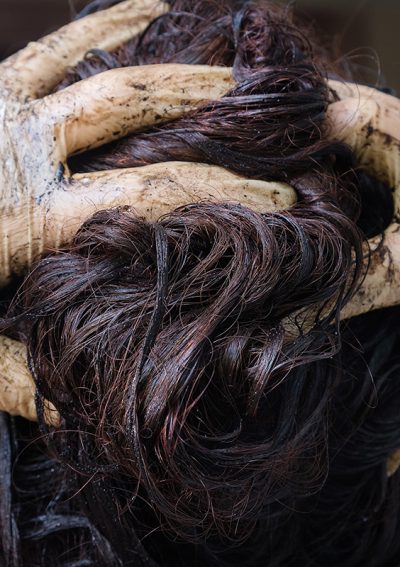Hair Dye Breast Cancer Lawsuit
Women diagnosed with breast cancer after long-term, frequent use of permanent hair dye may qualify to file a hair dye breast cancer lawsuit. Studies found a link between permanent hair dye and increased risk of breast cancer, with Black women having the highest risk.

Can Hair Dye Cause Breast Cancer?
Research hasn’t definitively said if hair dye causes breast cancer. However, studies have found that it’s associated with an increased risk of developing breast cancer.
One of the main studies that evaluated breast cancer and hair dye use is the Sister Study, which lasted roughly eight years and evaluated 46,709 women who used hair dye and chemical straighteners.
Researchers in the Sister Study looked at three main hair products and their link to breast cancer. These included permanent hair dye, semi-permanent hair dye and chemical hair relaxers.
What the Science Says About Hair Dye and Breast Cancer
Researchers published their findings from the Sister Study in the International Journal of Cancer. They found that permanent hair dye use was associated with a 45% greater risk of breast cancer in Black women and 7% higher risk in white women.
Semi-permanent dye use in general didn’t result in an increased breast cancer risk. The study found that women who used semi-permanent hair dye independently without professional help had a 28% greater risk of breast cancer.
Temporary dye wasn’t associated with an increased risk.
Researchers also found a link between chemical hair relaxers and cancer. Women who use relaxers every five to eight weeks had a 30% greater risk of developing breast cancer.
Who May Be Most at Risk?
Black women are most at risk of developing breast cancer from permanent hair dye use. Their overall risk of developing breast cancer from permanent hair dye was 45% compared to 7% for white women.
Additionally, Black women who frequently used hair dye at least every five to eight weeks had a 60% higher breast cancer risk.
Breast Cancers Linked to Hair Dye Use
There are two general types of breast cancer linked to hair dye use. These are hormone receptor-positive breast cancer and triple-negative breast cancer.
Hormone Receptor-Positive Breast Cancer
Hormone receptor-positive breast cancer consists of a tumor that tests positive for hormone receptors for estrogen, progesterone or both.
Tumors that are estrogen positive or positive for both estrogen and progesterone make up about 80% of hormone receptor-positive breast cancers.
One study in Carcinogenesis found that Black women who used darker shades of permanent hair dye had a 51% increased risk of breast cancer overall and a 72% increased risk of developing estrogen-positive cancer.
Triple-Negative Breast Cancer
Triple-negative breast cancer (TNBC) is a rare form of breast cancer that doesn’t test positive for three hormone receptors usually found in other breast cancers. These include estrogen receptors, progesterone receptors or Human Epidermal Growth Factor Receptor 2.
TNBC accounts for roughly 15% of breast cancer cases. It’s more difficult to treat because it doesn’t respond to treatment that targets hormone receptors. It’s also more aggressive and spreads faster than other types of breast cancer.
There isn’t much research on TNBC and hair dye, but one study published in The BMJ found that personal use of permanent hair dye could increase the risk for TNBC.
Who Qualifies for a Hair Dye Breast Cancer Lawsuit?
Women who frequently used permanent hair dye and received a breast cancer diagnosis might qualify to file a hair dye lawsuit.
Cosmetologists and other hair professionals who are regularly exposed to permanent hair dye may be more at risk because of constant, long-term exposure. This may make them eligible to file a lawsuit.
If you aren’t sure whether you qualify, you can contact a lawyer. They can tell you if you might be able to file a lawsuit.
In addition to hair dye lawsuits, lawyers are also filing chemical hair straightener lawsuits on behalf of women who suffered from hair relaxer side effects like cancer.
What Hair Dye Lawsuit Compensation Could Cover
Compensation from a hair dye lawsuit could cover physical, emotional and financial losses. Each case is different and depends on the damages a person suffers because of their injury.
- Annoyance
- Economic damages, including lost wages
- Embarrassment
- Emotional pain and suffering
- Fear of cancer returning
- Humiliation
- Inconvenience
- Loss of enjoyment of life
- Medical and hospital costs
- Physical injuries
- Substantial emotional distress
If you are married to someone who developed cancer after using chemical hair products, you may potentially claim loss of consortium. This is a claim that’s intended to compensate for the loss of emotional benefits and companionship of a spouse who’s been injured.
What to Expect After Filing a Hair Dye Lawsuit
After filing a hair dye lawsuit, your lawyer and the defendant’s lawyers will exchange information about your case, including medical records and expert opinions. This is called discovery. Your case may be settled or resolved at any time before trial.
Most product liability cases, like hair dye lawsuits, often resolve or settle before trial. However, if your case is selected for trial, your lawyer will walk you through the process.
You may or may not have to go to court. Complex cases like hair dye cancer lawsuits could take several years to resolve, but your lawyer will help you through the process.
If you need a lawyer, Consumer Notice can connect you with an experienced law firm for free. You aren’t obligated to file a lawsuit, and you can get your questions answered. Having more information can help you decide what’s best for you and your family.
19 Cited Research Articles
Consumernotice.org adheres to the highest ethical standards for content production and references only credible sources of information, including government reports, interviews with experts, highly regarded nonprofit organizations, peer-reviewed journals, court records and academic organizations. You can learn more about our dedication to relevance, accuracy and transparency by reading our editorial policy.
- American Cancer Society. (2025, June 25). Triple-Negative Breast Cancer. Retrieved from https://www.cancer.org/cancer/types/breast-cancer/about/types-of-breast-cancer/triple-negative.html
- Cleveland Clinic. (2025, April 23). Triple-Negative Breast Cancer. Retrieved from https://my.clevelandclinic.org/health/diseases/21756-triple-negative-breast-cancer-tnbc
- U.S. District Court for the Central District of California. (2025, March 6). Complaint. Retrieved from https://ecf.cacd.uscourts.gov/doc1/031144404976
- Cleveland Clinic. (2023, October 25). Can Hair Dye Increase Cancer Risk? Retrieved from https://health.clevelandclinic.org/hair-dye-and-breast-cancer-risk
- Chang, C., et al. (2022, December 8). Use of Straighteners and Other Hair Products and Incident Uterine Cancer. Retrieved from https://pubmed.ncbi.nlm.nih.gov/36245087/
- National Institutes of Health. (2022, October 17). Hair Straightening Chemicals Associated With Higher Uterine Cancer Risk. Retrieved from https://www.nih.gov/news-events/news-releases/hair-straightening-chemicals-associated-higher-uterine-cancer-risk
- National Institutes of Health. (2022). Frequent Use of Chemical Hair Straighteners and Relaxers Is Associated With Uterine Cancer. Retrieved from https://irp.nih.gov/accomplishments/frequent-use-of-chemical-hair-straighteners-and-relaxers-is-associated-with
- Eberle, C., et al. (2021, July 15). Hair Dye and Chemical Straightener Use and Breast Cancer Risk in a Large US Population of Black and White Women. Retrieved from https://pmc.ncbi.nlm.nih.gov/articles/PMC7246134/
- Zhang, Y., et al. (2020, September 2). Personal Use of Permanent Hair Dyes and Cancer Risk and Mortality in US Women: Prospective Cohort Study. Retrieved from https://pubmed.ncbi.nlm.nih.gov/32878860/
- National Institutes of Health. (2019, December 4). Permanent Hair Dye and Straighteners May Increase Breast Cancer Risk. Retrieved from https://www.nih.gov/news-events/news-releases/permanent-hair-dye-straighteners-may-increase-breast-cancer-risk
- National Institutes of Health. (2019, December 4). Permanent Hair Dye and Straighteners May Increase Breast Cancer Risk. Retrieved from https://www.niehs.nih.gov/newsreleases/permanent-hair-dye-and-straighteners-may-increase-breast-cancer-risk
- Eberle, C.E., et al. (2019, December 3). Hair Dye and Chemical Straightener Use and Breast Cancer Risk in a Large US Population of Black and White Women. Retrieved from https://pmc.ncbi.nlm.nih.gov/articles/PMC7246134/
- Llanos, A.A.M. et al. (2017, June 9). Hair Product Use and Breast Cancer Risk Among African American and White Women. Retrieved from https://pmc.ncbi.nlm.nih.gov/articles/PMC5862263/
- Harling, M., et. al. (2010, May 6). Bladder Cancer Among Hairdressers: A Meta-Analysis. Retrieved from https://pmc.ncbi.nlm.nih.gov/articles/PMC2981018/#sec26
- Compass Oncology. (n.d.). Does Hair Dye Cause Breast Cancer? Retrieved from https://www.compassoncology.com/blog/does-hair-dye-cause-breast-cancer
- Cornell Law School. (n.d.). Loss of Consortium. Retrieved from https://www.law.cornell.edu/wex/loss_of_consortium
- PennMedicine. (n.d.). Hormone Receptor-Positive (HR+) Breast Cancer. Retrieved from https://www.pennmedicine.org/conditions/hr-positive-breast-cancer
- PennMedicine. (n.d.). Triple Negative Breast Cancer (TNBC). Retrieved from https://www.pennmedicine.org/conditions/triple-negative-breast-cancer
- Rutgers Health Cancer Institute. (n.d.). Use of Dark Hair Dye and Relaxers Associated with Increased Breast Cancer Risk. Retrieved from https://www.cinj.org/use-dark-hair-dye-and-relaxers-associated-increased-breast-cancer-risk
Calling this number connects you with a Consumer Notice, LLC representative. We will direct you to one of our trusted legal partners for a free case review.
Consumer Notice, LLC's trusted legal partners support the organization's mission to keep people safe from dangerous drugs and medical devices. For more information, visit our partners page.
844-386-2236

